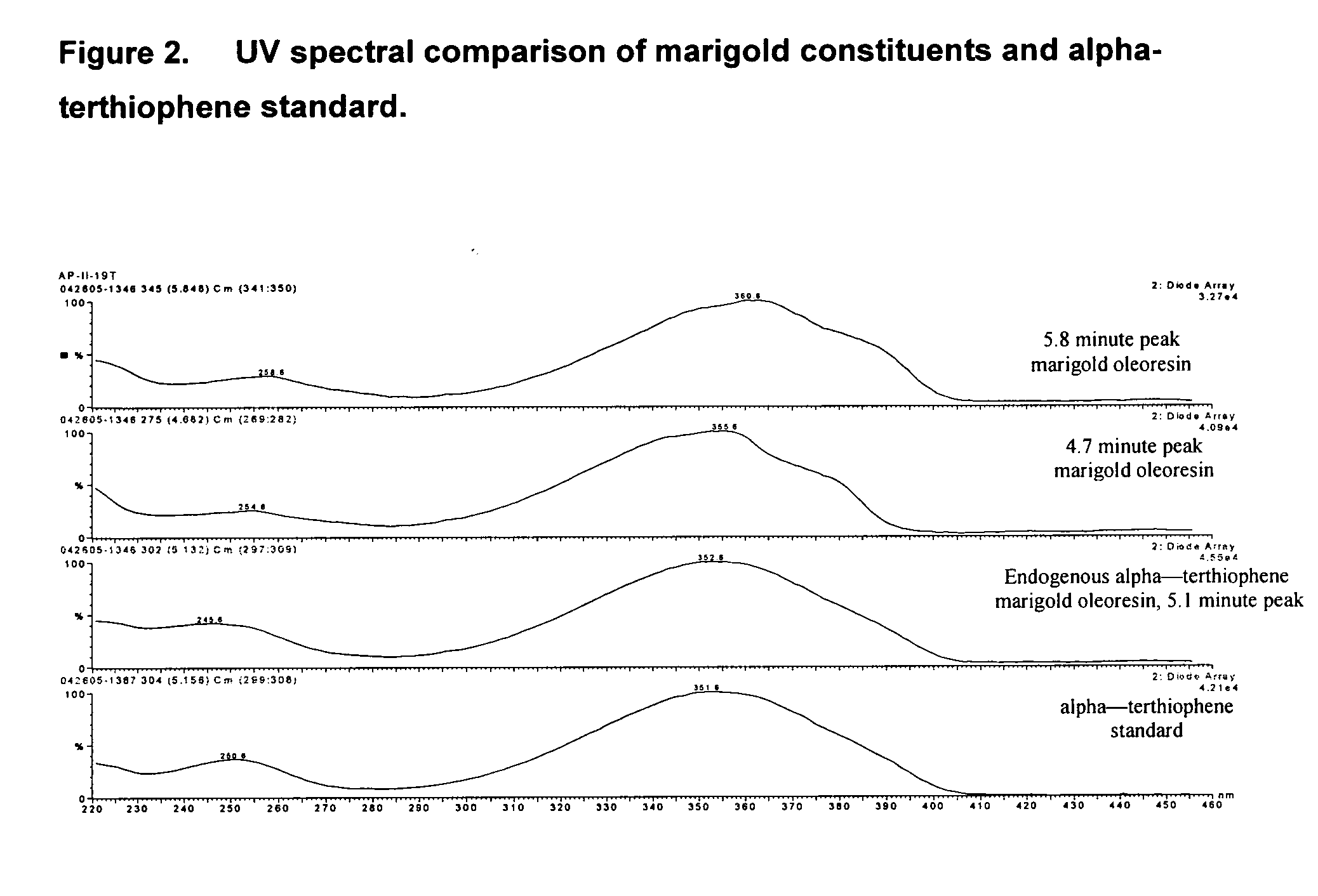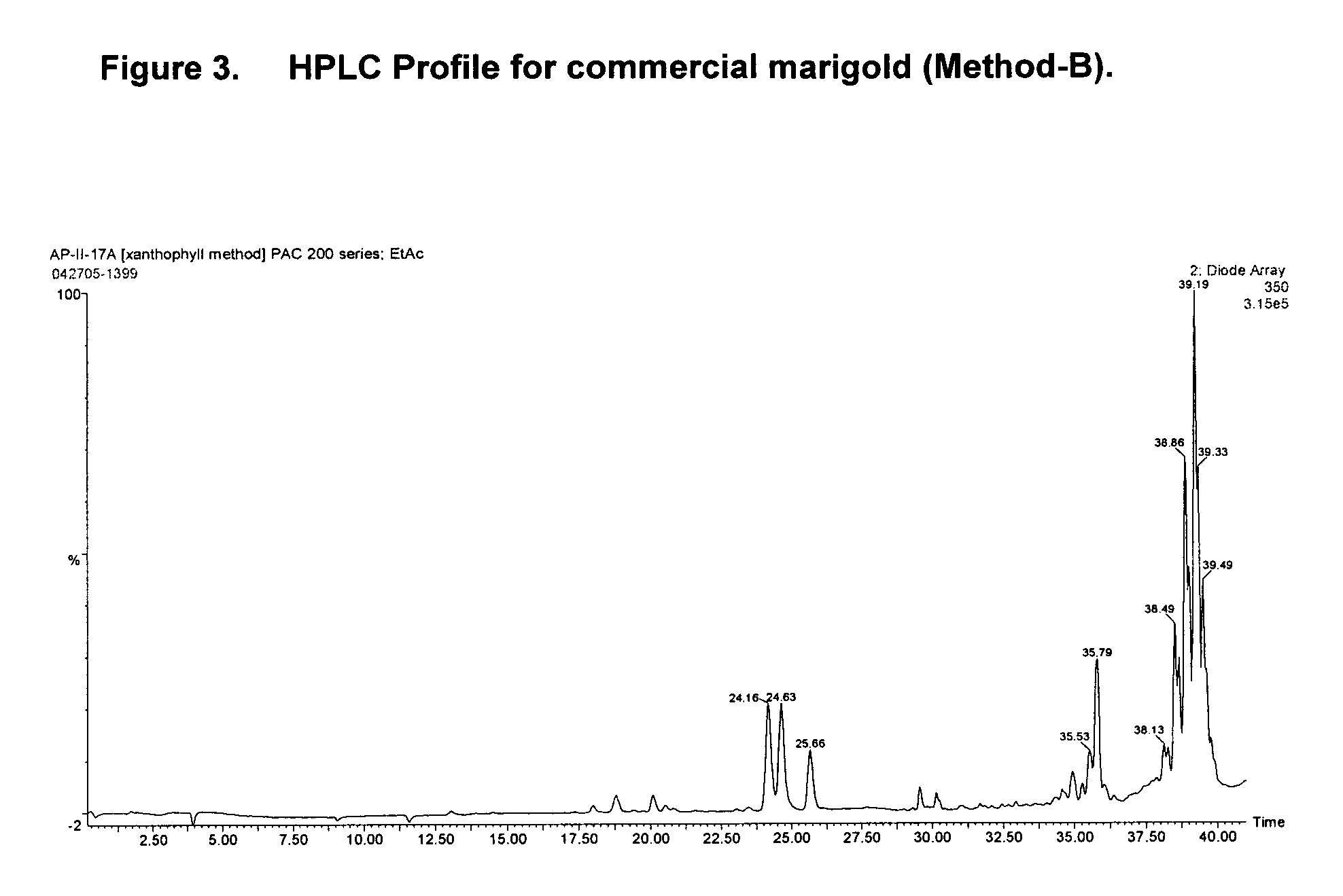Extracts of Asteraceae containing reduced levels of phototoxic thiophene derivatives and methods for preparing same
a technology of asteraceae and thiophene derivatives, which is applied in the direction of biocide, drug composition, anti-noxious agents, etc., can solve the problems of limiting the usefulness of tagetes extracts in nutritional supplements, cosmetic and eye health applications, and the presence of phototoxic sensitizing agents in nutritional supplements. , to achieve the effect of obtaining the putative beneficial effect of compound, purified or synthetic carotenoids are less effective ways
- Summary
- Abstract
- Description
- Claims
- Application Information
AI Technical Summary
Benefits of technology
Problems solved by technology
Method used
Image
Examples
example 1
[0049] This external standard method specifically targets the thiophene group of analytes, to the exclusion of the xanthophylls. It is a rapid and accurate way to monitor the thiophene content of marigold oleoresins as well as to track their subsequent removal by the processes described herein. The oleoresin was initially dissolved in a suitable organic solvent such as hexane, ethyl acetate or methyl tert-butyl ether. A typical concentration, depending upon the xanthophyll content and / or the oleoresin solubility characteristics, was approximately 20 mg oleoresin per mL solvent. This analysis solution was processed by the following instrumental method: [0050] Reagents are ACS grade, and the solvents are HPLC grade. A Waters HPLC 2695 separations module wass configured with mobile phase components of 5 mM ammonium acetate (A) and acetonitrile (B). The HPLC column consists of two 5 cm by 2.1 mm Zorbax XDB C18 columns in series, with a Phenomenex C18 Securityguard™ cartrid...
example 2
[0054] This method generates qualitative and quantitative profiles of both the thiophenes and the xanthophylls in the marigold oleoresins. Sample preparation and the HPLC instrumentation was the same as for Method A of Example 1, except that the PDA was set to scan from 210 nm to 690 nm. The HPLC profiles were viewed at 350 nm wavelength, which yielded a useful profile of the thiophenes as well as the xanthophylls. The mobile phase components were 5 mM ammonium acetate (A), methyl tert-butyl ether (B), and acetonitrile (C). The method used the following gradient:
TimeA %B %C %FlowCurve0.0098.00.02.00.200120.0030.00.070.00.300625.005.00.095.00.300840.005.070.025.00.400641.005.00.095.00.400642.005.00.095.00.400143.0098.00.02.00.400150.0098.00.02.00.400154.0098.00.02.00.400155.0098.00.02.00.2001
[0055] The resulting profile revealed two general regions of interest. The thiophene elution region was apparent at approximately 24-26 minutes and the xanthophylls eluted between...
example 3
Determining α-terthiophene (α-terthienyl) Levels in Commercial Sources of Zeaxanthin and Lutein by GC-EI-MS and GC-PFPD
[0058] The analyses were performed on a Varian 3800 gas chromatograph in-line with a Saturn 2000 ion trap mass spectrometer. The mass spectrometer was operated in the electron ionization mode with scanning from 40 u to 650 u. The NIST Standard Reference Database, version 1.6 was used for peak identification. The GC-pulsed flame photometric detector was configured for sulfur-specific detection as per vendor specification. Data acquisition utilized the Varian Saturn GC / MS data station (v5.51). Gas chromatography was performed on a Supelco MDN-5S fused silica capillary column, 30 m×0.25 mm i.d., 0.25 um film (p / n 24384)). The column flow rate was 1.5 ml helium / minute; the injector temperature was 240° C.; the detector temperature was 230° C.; the oven temperature program was 120° C. to 260° C. at 8° C. / minute, hold at 260° C. for 4.5 minutes; the injector split ratio ...
PUM
 Login to View More
Login to View More Abstract
Description
Claims
Application Information
 Login to View More
Login to View More - R&D
- Intellectual Property
- Life Sciences
- Materials
- Tech Scout
- Unparalleled Data Quality
- Higher Quality Content
- 60% Fewer Hallucinations
Browse by: Latest US Patents, China's latest patents, Technical Efficacy Thesaurus, Application Domain, Technology Topic, Popular Technical Reports.
© 2025 PatSnap. All rights reserved.Legal|Privacy policy|Modern Slavery Act Transparency Statement|Sitemap|About US| Contact US: help@patsnap.com



